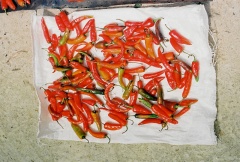Difference between revisions of "Chilies"
| (29 intermediate revisions by the same user not shown) | |||
| Line 2: | Line 2: | ||
| image = chilies.jpg | | image = chilies.jpg | ||
| origin = <ul><li>Europe</li><li>Africa: Nigeria, Kenya, Uganda</li><li>Asia: India, China, Korea, Vietnam, Pakistan, Thailand, Japan</li><li>America: Mexico, USA</li><li>Australia</li></ul> | | origin = <ul><li>Europe</li><li>Africa: Nigeria, Kenya, Uganda</li><li>Asia: India, China, Korea, Vietnam, Pakistan, Thailand, Japan</li><li>America: Mexico, USA</li><li>Australia</li></ul> | ||
| − | | stowage factor = <ul><li>3.53 | + | | stowage factor = <ul><li>3.53 m<sup>3</sup>/t (flat jute fabric bags, 20 kg)<br><li>2.65 - 3.07 m<sup>3</sup>/t (bags)<br><li>5.57 - 6.97 m<sup>3</sup>/t (bales)<br> <li>1.80 - 2.51 m<sup>3</sup>/t (cayenne pepper in bags) |
| − | | humidity and moisture = <ul><li>Relative humidity 60 - 70%< | + | | humidity and moisture = <ul><li>Relative humidity 60 - 70%</li><li>Water content 8 - 12%</li><li>Maximum equilibrium moisture content 65% |
| − | | oil content = | + | | oil content =1.0- 3.2% essential oils, in particular capsaicin |
| − | | ventilation = | + | | ventilation = If the product is at "shipping dryness", it does not have to be ventilated during transport. However, if the water content is excessive, apply air exchange rate of 10 changes/hour (airing) |
| − | | risk factors = | + | | risk factors = In addition to the residual water content remaining after drying, the risk of self-heating is also explained by the relatively high content of fatty oils. |
}} | }} | ||
| − | + | __TOC__ | |
| − | + | ==Description== | |
| − | + | Chili [[pepper]] pods, which are berries, are used fresh or dried. Chilies are dried to preserve them for long periods of time or may also be done by pickling.<br> | |
| − | + | Dried chilies (i.e. [[hot peppers]]) are often ground into powders, although the entire chili can be used also. Dried whole chilies may be reconstituted before grinding to a paste. <br> | |
| − | + | The color of the conically pointed pods range from orange-yellow to yellowish-red and they are a hotter spice than the larger sweet peppers. <br> | |
| − | + | After processing, spices are cleaned, graded, dried and packed for overseas dispatch. In importing countries, they are delivered to spice mills, where they are cleaned and graded again, to be traded as ground or unground produce. | |
| − | + | <br><br> | |
| − | + | See also [[Capsicum]]<br><br> | |
| − | + | ==Applications== | |
| − | + | Chilies are used in the food and pharmaceutical industry. <br><br> | |
| − | + | ==Shipment / storage== | |
| − | + | Chilies are packed and transported in bags. Extraneous moisture affection may initiate mold growth, spoilage and self-heating. | |
| − | + | <br><br> | |
| − | + | <b>Temperature</b><br> | |
| − | + | Favourable travel temperature range is 5° - 25°C. At temperatures of > 25°C, [[Essential Oils]] may be lost and there is a risk of self-heating.<br><br> | |
| − | + | ==Risk factors== | |
| + | * Self-heating / Spontaneous combustion<br> | ||
| + | * Odor<br> | ||
| + | * Contamination<br> | ||
| + | * Mechanical influences<br> | ||
| + | * Toxicity / Hazards to health<br> | ||
| + | * Shrinkage / Shortage<br> | ||
| + | * Insect infestation / Diseases<br> | ||
| + | <br><br> | ||
[[Category: Products]][[Category: Food and beverages]] | [[Category: Products]][[Category: Food and beverages]] | ||
Latest revision as of 12:29, 8 January 2013
| Infobox on Chilies | |
|---|---|
| Example of Chilies |  |
| Facts | |
| Origin |
|
| Stowage factor (in m3/t) |
|
| Humidity / moisture |
|
| Oil content | 1.0- 3.2% essential oils, in particular capsaicin |
| Ventilation | If the product is at "shipping dryness", it does not have to be ventilated during transport. However, if the water content is excessive, apply air exchange rate of 10 changes/hour (airing) |
| Risk factors | In addition to the residual water content remaining after drying, the risk of self-heating is also explained by the relatively high content of fatty oils. |
Chilies
Description
Chili pepper pods, which are berries, are used fresh or dried. Chilies are dried to preserve them for long periods of time or may also be done by pickling.
Dried chilies (i.e. hot peppers) are often ground into powders, although the entire chili can be used also. Dried whole chilies may be reconstituted before grinding to a paste.
The color of the conically pointed pods range from orange-yellow to yellowish-red and they are a hotter spice than the larger sweet peppers.
After processing, spices are cleaned, graded, dried and packed for overseas dispatch. In importing countries, they are delivered to spice mills, where they are cleaned and graded again, to be traded as ground or unground produce.
See also Capsicum
Applications
Chilies are used in the food and pharmaceutical industry.
Shipment / storage
Chilies are packed and transported in bags. Extraneous moisture affection may initiate mold growth, spoilage and self-heating.
Temperature
Favourable travel temperature range is 5° - 25°C. At temperatures of > 25°C, Essential Oils may be lost and there is a risk of self-heating.
Risk factors
- Self-heating / Spontaneous combustion
- Odor
- Contamination
- Mechanical influences
- Toxicity / Hazards to health
- Shrinkage / Shortage
- Insect infestation / Diseases











